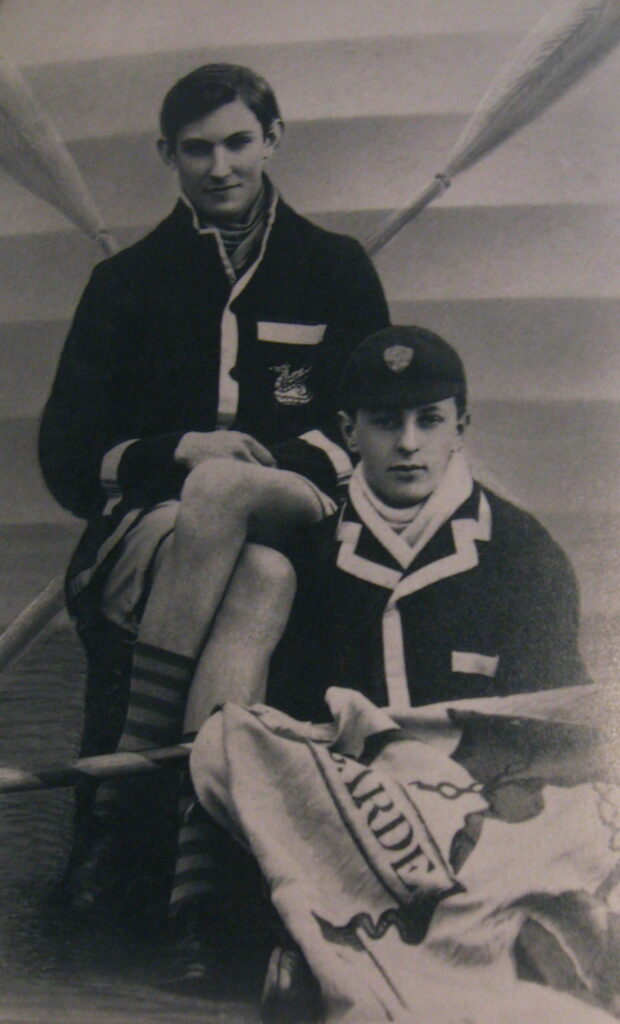Recognized for his pioneering attitude & desire to summit Mount Everest, George Mallory is a legendary figure in climbing history. His tale is one of audacious ambition, unshakable bravery, and everlasting devotion to his climbing obsession.
Mallory, born in Mobberley, Cheshire, England, in 1886, fell in love with climbing at a young age. From the beginning, he showed a natural talent for the sport and made a name for himself as an accomplished and daring climber. Mallory began his famous quest to climb the “roof of the world” in 1921 when he enlisted in the first British Mount Everest reconnaissance team.

“One must conquer, achieve, get to the top; one must know the end to be convinced that one can win the end – to know there’s no dream that mustn’t be dared.”
George Mallory's Early Life & Introduction to Mountaineering
Born in Mobberley, Cheshire, England, on June 18, 1886, George Herbert Leigh Mallory was a world-famous mountaineer who enthralled audiences with his audacious attempts to summit Mount Everest. Early in life, a combination of familial influences, personal experiences, and a profound love of the natural environment sparked his enthusiasm for climbing.
A Childhood Steeped in Adventure
Mallory had an adventurous and exploratory personality throughout his early years. His father, the parish rector, Reverend Herbert Leigh Mallory, supported his son’s interest in the great outdoors. Mallory spent many hours trekking and scrambling in the Lake District during the family’s many vacations, which sparked her passion for the mountains.
The Influence of Winchester College
Mallory was awarded a mathematics scholarship to Winchester College, a prominent boarding school known for its emphasis on physical fitness and outdoor pastimes when he was 13 years old. It was here that his love of climbing grew. Mallory showed a natural affinity for mountaineering during school excursions to the Alps, exhibiting outstanding balance, agility, and a fearless approach to hard terrain.
The Inspiration of Geoffrey Winthrop Young
Mallory’s life was turned upside down in 1909 when he met Geoffrey Winthrop Young, an experienced mountaineer who became a longtime companion and mentor. Young exposed Mallory to the complexities of alpine climbing, teaching him basic methods and instilling in him a great respect for the majesty and grandeur of the mountains.
The Birth of a Passion
Mallory’s experiences in the Lake District, Winchester College, and the Alps sparked a lifelong enthusiasm for climbing. The difficulty of scaling huge peaks, the pleasure of discovering unexplored area, and the profound connection he felt with nature all attracted him.
“The greatest danger in life is not to take the adventure.”
Mallory's Notable Early Expeditions
1921 British Mount Everest Reconnaissance Expedition
Mallory’s first foray into the Himalayas came in 1921 when he joined the British Mount Everest reconnaissance expedition. The primary objective of this expedition was to gather information about the mountain’s terrain, routes, and weather conditions, laying the groundwork for future attempts to reach the summit.
Notable Successes:
- Mallory and his climbing partner, Guy Bullock, explored the Rongbuk Glacier, a potential route to the summit.
- They reached an altitude of 23,000 feet (7,000 meters), a remarkable feat at the time.
- Mallory’s detailed observations and meticulous route-finding proved invaluable for subsequent expeditions.
1922 British Mount Everest Expedition
Emboldened by the success of the reconnaissance expedition, Mallory returned to Everest in 1922 as part of the second British expedition. This time, the team aimed to make a serious attempt to reach the summit, using supplemental oxygen for the first time in Everest expeditions.
Notable Successes:
- Mallory and his climbing partner, Howard Somervell, reached an altitude of 28,316 feet (8,629 meters), a new record at the time.
- They demonstrated the effectiveness of using supplemental oxygen, paving the way for future Everest ascents.
- Mallory’s innovative use of ladders and ropes helped the team overcome technical challenges.

Influence and Inspiration
Mallory’s legacy includes not only his climbing achievements but also the significant influence he has had on future generations of adventurers. His narrative continues to encourage people to push themselves, face the unknown, and follow their aspirations with tenacity.
“Because it’s there”… Mallory’s remarks reflect the essence of mountaineering and the adventurous spirit that inspires people to explore the world’s most difficult and awe-inspiring environments.
The Enduring Enigma
He was a pioneer in his field, developing innovative techniques and equipment that helped to push the boundaries of what was considered possible. He was also a skilled and fearless climber, who was willing to take risks to achieve his goals. His legacy continues to inspire mountaineers and adventurers worldwide.
Mallory’s most significant contribution to mountaineering was his development of the use of supplemental oxygen. This was a revolutionary idea at the time, and it allowed climbers to reach higher altitudes than ever before. Mallory also used ladders and ropes to overcome technical challenges, and he was a skilled route-finder. His observations and insights were invaluable to subsequent expeditions to Everest.
His contributions to exploration are also significant. He was one of the first Europeans to explore the Himalayas, and he helped to open up this region to other climbers and adventurers. He also made detailed observations of the mountain’s terrain, weather patterns, and flora and fauna. His work helped to improve our understanding of the Himalayas and their inhabitants.
George Mallory’s disappearance on Everest in 1924, and the enduring mystery of whether he and Irvine summited before their tragic end, have continued to captivate the world.
The question of whether Mallory was the first to conquer Everest, predating Sir Edmund Hillary and Tenzing Norgay’s successful 1953 ascent, remains an enigma…

